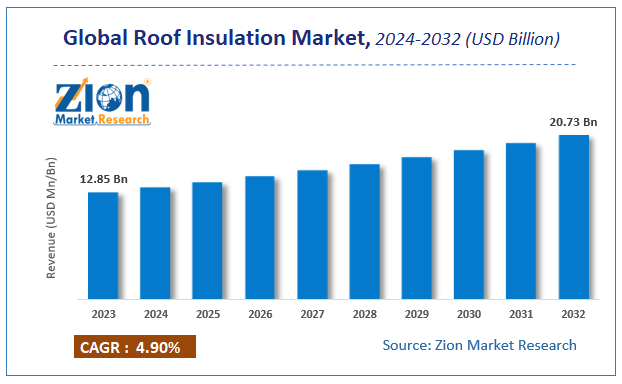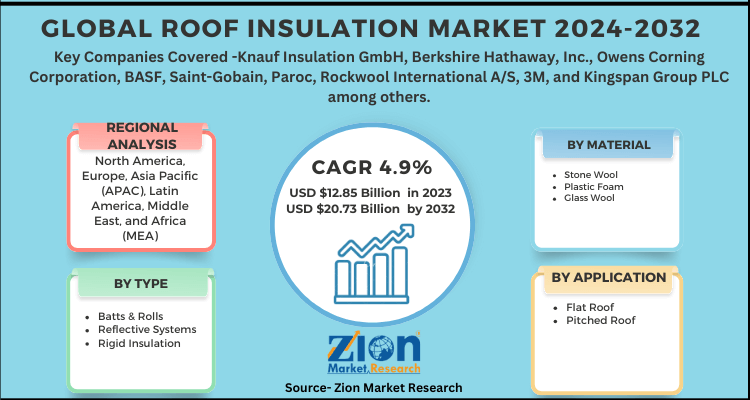Roof Insulation Market Size, Share, Trends, Growth 2032

Roof Insulation Market By Type (Batts & Rolls, Reflective Systems, Rigid Insulation), By Material (Stone Wool, Plastic Foam, Glass Wool), and By Application (Flat Roof and Pitched Roof): Global Industry Perspective, Comprehensive Analysis, and Forecast, 2024 - 2032-
| Market Size in 2023 | Market Forecast in 2032 | CAGR (in %) | Base Year |
|---|---|---|---|
| USD 12.85 Billion | USD 20.73 Billion | 4.9% | 2023 |
Roof Insulation Market Insights
Zion Market Research has published a report on the global Roof Insulation Market, estimating its value at USD 12.85 Billion in 2023, with projections indicating that it will reach USD 20.73 Billion by 2032. The market is expected to expand at a compound annual growth rate (CAGR) of 4.9% over the forecast period 2024-2032. The report explores the factors fueling market growth, the hitches that could hamper this expansion, and the opportunities that may arise in the Roof Insulation Market industry. Additionally, it offers a detailed analysis of how these elements will affect market demand dynamics and market performance throughout the forecast period.
Global Roof Insulation Market: Overview
Roof insulation is used to minimize the diffusion of energy, moisture, heat, sound, and shock from one medium to another. This aims to minimize noise emissions, enhance comfort, reduce energy costs, and preserve a healthier atmosphere. Insulation has been a major component of the roof assembly and the structural deck and membrane functions. It makes the house colder in winter and hotter in summer, lowers costs for gas and power, reduces outdoor noise, and tends to decrease the house's carbon footprint.
Global Roof Insulation Market: Growth Factors
Tax incentives, strict government environmental regulations, and the rise in new building activities are some of the key factors responsible for the development of the global roof insulation industry. Nevertheless, the lack of knowledge of suitable insulating materials and sluggish development in the building sector is hampering the growth of the global industry.
The arrival of new companies with affordable pricing for insulation and roofing materials and the growing interest in energy-efficient buildings in the construction industry are some of the influential factors driving the global market. Also, increased demand for isolating materials in extreme weather countries would encourage the development of insulating materials.
Global Roof Insulation Market: Segmentation
The global roof insulation market is type categorized as batts & rolls, reflective systems, and rigid insulation, out of which the batts & rolls are the dominant segments around the globe as it gives proper insulation, are cost-effective, and are easy to use as well. It is also available in the form of panels and rolls which are pre-cut. Owing to its versatility, it is simple to mount between blocks of studs and joists without gaps. Such insulation is capable of reducing the amount of energy used to cool and heat the building by 50 percent.
Based on material type, the global roof insulation market is segmented into stone wool, plastic foam, and glass wool. Of these, glass wool is the world's leading segment and highly favored roof insulation material, and its development is expected to continue in the immediate future. Along with exceptional mechanical and thermal properties, it is non-degradable, less costly, and non-combustible.
Based on the application, the global roof insulation market is divided into flat roofs and pitched roofs. The flat roof application segment is anticipated to dominate the overall market as they are cost-effective roof slopes and all room space can be completely used. Also, because of the direct solar energy falling on the roof, flat roofs tend to gain heat.
Roof Insulation Market: Report Scope
| Report Attributes | Report Details |
|---|---|
| Report Name | Roof Insulation Market |
| Market Size in 2023 | USD 12.85 Billion |
| Market Forecast in 2032 | USD 20.73 Billion |
| Growth Rate | CAGR of 4.9% |
| Number of Pages | 110 |
| Key Companies Covered | Knauf Insulation GmbH, Berkshire Hathaway, Inc., Owens Corning Corporation, BASF, Saint-Gobain, Paroc, Rockwool International A/S, 3M, and Kingspan Group PLC among others. |
| Segments Covered | By material type, By application and By Region |
| Regions Covered | North America, Europe, Asia Pacific (APAC), Latin America, Middle East, and Africa (MEA) |
| Base Year | 2023 |
| Historical Year | 2018 to 2022 |
| Forecast Year | 2024 - 2032 |
| Customization Scope | Avail customized purchase options to meet your exact research needs. Request For Customization |
Global Roof Insulation Market: Regional Analysis
Europe is the dominant market for roof insulation; the rise in residential and non-residential construction in this region is expected to foster the growth of the global market for roof insulation. Due to growth in industrialization, North America is the second-largest market that is growing at a faster rate. Soon, the Asia Pacific roof insulation market will experience higher growth. The global roof insulation market is triggered by environmental concerns about buildings and energy savings in countries such as China and India.
Global Roof Insulation Market: Competitive Players
Some of the key players in the roof insulation market are
- Knauf Insulation GmbH
- Berkshire Hathaway, Inc
- Owens Corning Corporation
- BASF
- Saint-Gobain
- Paroc
- Rockwool International A/S
- 3M
- Kingspan Group PLC
The global roof insulation market is segmented as follows:
By Type
- Batts & Rolls
- Reflective Systems
- Rigid Insulation
By Material
- Stone Wool
- Plastic Foam
- Glass Wool
By Application
- Flat Roof
- Pitched Roof
Global Roof Insulation Market: Regional Segment Analysis
- North America
- The U.S.
- Canada
- Europe
- France
- The UK
- Spain
- Germany
- Italy
- Rest of Europe
- Asia Pacific
- China
- Japan
- India
- South Korea
- Southeast Asia
- Rest of Asia Pacific
- Latin America
- Brazil
- Mexico
- Rest of Latin America
- Middle East & Africa
- GCC
- South Africa
- Rest of The Middle East & Africa
Table Of Content
Methodology
FrequentlyAsked Questions
Roof insulation is the materials and methods applied, mostly through the roof, to lower heat transfer between the inside of a building and the outside surroundings. Good roof insulation improves general comfort in a structure, lowers heating and cooling energy consumption, and helps to keep inside temperature constant.
Homeowners and companies are increasingly likely to make roof insulating investments to lower heating and cooling costs when energy prices rise.
Zion Market Research has published a report on the global Roof Insulation Market, estimating its value at USD 12.85 Billion in 2023, with projections indicating that it will reach USD 20.73 Billion by 2032.
The market is expected to expand at a compound annual growth rate (CAGR) of 4.9% over the forecast period 2024-2032.
Europe is the dominant market for roof insulation; the rise in residential and non-residential construction in this region is expected to foster the growth of the global market for roof insulation. Due to growth in industrialization, North America is the second-largest market that is growing at a faster rate.
Some of the key players in the roof insulation market are Knauf Insulation GmbH, Berkshire Hathaway, Inc., Owens Corning Corporation, BASF, Saint-Gobain, Paroc, Rockwool International A/S, 3M, and Kingspan Group PLC among others.
HappyClients
Zion Market Research
Tel: +1 (302) 444-0166
USA/Canada Toll Free No.+1 (855) 465-4651
3rd Floor,
Mrunal Paradise, Opp Maharaja Hotel,
Pimple Gurav, Pune 411061,
Maharashtra, India
Phone No +91 7768 006 007, +91 7768 006 008
US OFFICE NO +1 (302) 444-0166
US/CAN TOLL FREE +1 (855) 465-4651
Email: sales@zionmarketresearch.com
We have secured system to process your transaction.
Our support available to help you 24 hours a day, five days a week.
Monday - Friday: 9AM - 6PM
Saturday - Sunday: Closed






